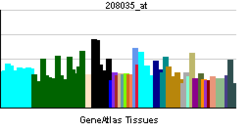- Metabotropic glutamate receptor 6
-
Glutamate receptor, metabotropic 6 Identifiers Symbols GRM6; CSNB1B; DKFZp686H1993; GPRC1F; MGLUR6; mGlu6 External IDs OMIM: 604096 HomoloGene: 20232 IUPHAR: mGlu6 GeneCards: GRM6 Gene Gene Ontology Molecular function • adenylate cyclase inhibiting metabotropic glutamate receptor activity
• receptor activity
• G-protein coupled receptor activity
• glutamate receptor activityCellular component • plasma membrane
• integral to plasma membraneBiological process • metabotropic glutamate receptor signaling pathway
• synaptic transmission
• visual perception
• locomotory behavior
• detection of visible light
• response to stimulusSources: Amigo / QuickGO RNA expression pattern 
More reference expression data Orthologs Species Human Mouse Entrez 2916 n/a Ensembl ENSG00000113262 n/a UniProt O15303 n/a RefSeq (mRNA) NM_000843 n/a RefSeq (protein) NP_000834 n/a Location (UCSC) Chr 5:
178.39 – 178.42 Mbn/a PubMed search [1] n/a Glutamate receptor, metabotropic 6, also known as GRM6, is a protein which in humans is encoded by the GRM6 gene.[1][2]
Contents
Function
L-glutamate is the major excitatory neurotransmitter in the central nervous system and activates both ionotropic and metabotropic glutamate receptors. Glutamatergic neurotransmission is involved in most aspects of normal brain function and can be perturbed in many neuropathologic conditions. The metabotropic glutamate receptors are a family of G protein-coupled receptors, that have been divided into 3 groups on the basis of sequence homology, putative signal transduction mechanisms, and pharmacologic properties. Group I includes GRM1 and GRM5 and these receptors have been shown to activate phospholipase C. Group II includes GRM2 and GRM3, while Group III includes GRM4, GRM6, GRM7 and GRM8. Group II and III receptors are linked to the inhibition of the cyclic AMP cascade but differ in their agonist selectivities.[1]
See also
References
- ^ a b "Entrez Gene: GRM6 glutamate receptor, metabotropic 6". http://www.ncbi.nlm.nih.gov/sites/entrez?Db=gene&Cmd=ShowDetailView&TermToSearch=2916.
- ^ Hashimoto T, Inazawa J, Okamoto N, Tagawa Y, Bessho Y, Honda Y, Nakanishi S (June 1997). "The whole nucleotide sequence and chromosomal localization of the gene for human metabotropic glutamate receptor subtype 6". Eur. J. Neurosci. 9 (6): 1226–35. doi:10.1111/j.1460-9568.1997.tb01477.x. PMID 9215706.
External links
- "Metabotropic Glutamate Receptors: mGlu6". IUPHAR Database of Receptors and Ion Channels. International Union of Basic and Clinical Pharmacology. http://www.iuphar-db.org/GPCR/ReceptorDisplayForward?receptorID=2278.
Further reading
- Hashimoto T, Inazawa J, Okamoto N, et al. (1997). "The whole nucleotide sequence and chromosomal localization of the gene for human metabotropic glutamate receptor subtype 6". Eur. J. Neurosci. 9 (6): 1226–35. doi:10.1111/j.1460-9568.1997.tb01477.x. PMID 9215706.
- Dhingra A, Lyubarsky A, Jiang M, et al. (2001). "The light response of ON bipolar neurons requires G[alpha]o". J. Neurosci. 20 (24): 9053–8. PMID 11124982.
- Valerio A, Ferraboli S, Paterlini M, et al. (2001). "Identification of novel alternatively-spliced mRNA isoforms of metabotropic glutamate receptor 6 gene in rat and human retina". Gene 262 (1–2): 99–106. doi:10.1016/S0378-1119(00)00547-3. PMID 11179672.
- Dryja TP, McGee TL, Berson EL, et al. (2005). "Night blindness and abnormal cone electroretinogram ON responses in patients with mutations in the GRM6 gene encoding mGluR6". Proc. Natl. Acad. Sci. U.S.A. 102 (13): 4884–9. doi:10.1073/pnas.0501233102. PMC 555731. PMID 15781871. http://www.pubmedcentral.nih.gov/articlerender.fcgi?tool=pmcentrez&artid=555731.
- Zeitz C, van Genderen M, Neidhardt J, et al. (2005). "Mutations in GRM6 cause autosomal recessive congenital stationary night blindness with a distinctive scotopic 15-Hz flicker electroretinogram". Invest. Ophthalmol. Vis. Sci. 46 (11): 4328–35. doi:10.1167/iovs.05-0526. PMID 16249515.
- Zeitz C, Forster U, Neidhardt J, et al. (2007). "Night blindness-associated mutations in the ligand-binding, cysteine-rich, and intracellular domains of the metabotropic glutamate receptor 6 abolish protein trafficking". Hum. Mutat. 28 (8): 771–80. doi:10.1002/humu.20499. PMID 17405131.
This article incorporates text from the United States National Library of Medicine, which is in the public domain.

This transmembrane receptor-related article is a stub. You can help Wikipedia by expanding it.
